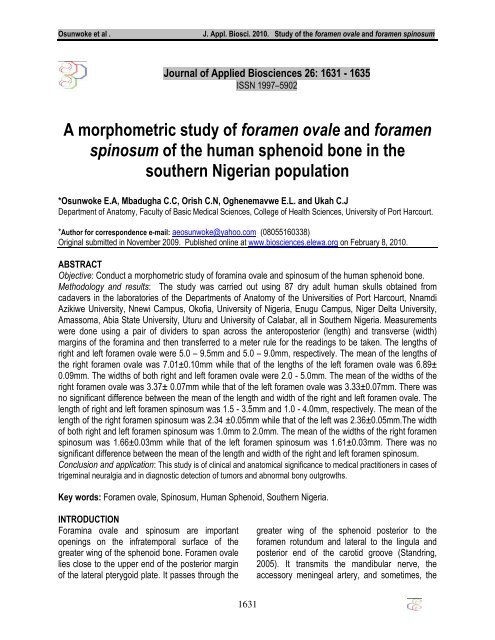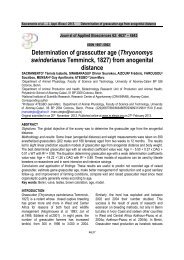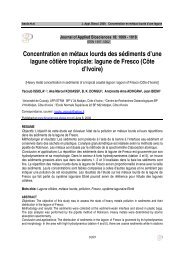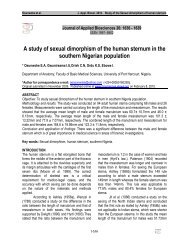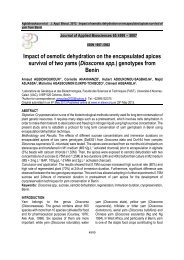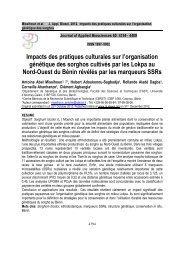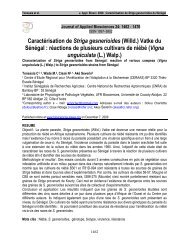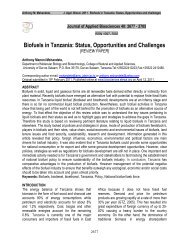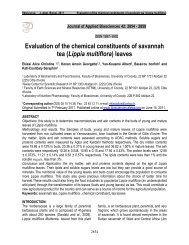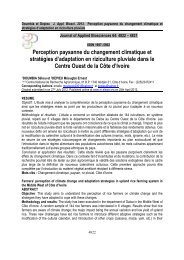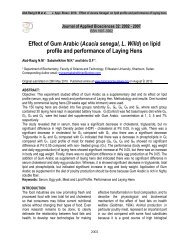A morphometric study of foramen ovale and foramen spinosum of ...
A morphometric study of foramen ovale and foramen spinosum of ...
A morphometric study of foramen ovale and foramen spinosum of ...
Create successful ePaper yourself
Turn your PDF publications into a flip-book with our unique Google optimized e-Paper software.
Osunwoke et al . . .…………………………...……J. Appl. Biosci. 2010. Study <strong>of</strong> the <strong>foramen</strong> <strong>ovale</strong> <strong>and</strong> <strong>foramen</strong> <strong>spinosum</strong>Journal <strong>of</strong> Applied Biosciences 26: 1631 - 1635ISSN 1997–5902A <strong>morphometric</strong> <strong>study</strong> <strong>of</strong> <strong>foramen</strong> <strong>ovale</strong> <strong>and</strong> <strong>foramen</strong><strong>spinosum</strong> <strong>of</strong> the human sphenoid bone in thesouthern Nigerian population*Osunwoke E.A, Mbadugha C.C, Orish C.N, Oghenemavwe E.L. <strong>and</strong> Ukah C.JDepartment <strong>of</strong> Anatomy, Faculty <strong>of</strong> Basic Medical Sciences, College <strong>of</strong> Health Sciences, University <strong>of</strong> Port Harcourt.*Author for correspondence e-mail: aeosunwoke@yahoo.com (08055160338)Original submitted in November 2009. Published online at www.biosciences.elewa.org on February 8, 2010.ABSTRACTObjective: Conduct a <strong>morphometric</strong> <strong>study</strong> <strong>of</strong> foramina <strong>ovale</strong> <strong>and</strong> <strong>spinosum</strong> <strong>of</strong> the human sphenoid bone.Methodology <strong>and</strong> results: The <strong>study</strong> was carried out using 87 dry adult human skulls obtained fromcadavers in the laboratories <strong>of</strong> the Departments <strong>of</strong> Anatomy <strong>of</strong> the Universities <strong>of</strong> Port Harcourt, NnamdiAzikiwe University, Nnewi Campus, Ok<strong>of</strong>ia, University <strong>of</strong> Nigeria, Enugu Campus, Niger Delta University,Amassoma, Abia State University, Uturu <strong>and</strong> University <strong>of</strong> Calabar, all in Southern Nigeria. Measurementswere done using a pair <strong>of</strong> dividers to span across the anteroposterior (length) <strong>and</strong> transverse (width)margins <strong>of</strong> the foramina <strong>and</strong> then transferred to a meter rule for the readings to be taken. The lengths <strong>of</strong>right <strong>and</strong> left <strong>foramen</strong> <strong>ovale</strong> were 5.0 – 9.5mm <strong>and</strong> 5.0 – 9.0mm, respectively. The mean <strong>of</strong> the lengths <strong>of</strong>the right <strong>foramen</strong> <strong>ovale</strong> was 7.01±0.10mm while that <strong>of</strong> the lengths <strong>of</strong> the left <strong>foramen</strong> <strong>ovale</strong> was 6.89±0.09mm. The widths <strong>of</strong> both right <strong>and</strong> left <strong>foramen</strong> <strong>ovale</strong> were 2.0 - 5.0mm. The mean <strong>of</strong> the widths <strong>of</strong> theright <strong>foramen</strong> <strong>ovale</strong> was 3.37± 0.07mm while that <strong>of</strong> the left <strong>foramen</strong> <strong>ovale</strong> was 3.33±0.07mm. There wasno significant difference between the mean <strong>of</strong> the length <strong>and</strong> width <strong>of</strong> the right <strong>and</strong> left <strong>foramen</strong> <strong>ovale</strong>. Thelength <strong>of</strong> right <strong>and</strong> left <strong>foramen</strong> <strong>spinosum</strong> was 1.5 - 3.5mm <strong>and</strong> 1.0 - 4.0mm, respectively. The mean <strong>of</strong> thelength <strong>of</strong> the right <strong>foramen</strong> <strong>spinosum</strong> was 2.34 ±0.05mm while that <strong>of</strong> the left was 2.36±0.05mm.The width<strong>of</strong> both right <strong>and</strong> left <strong>foramen</strong> <strong>spinosum</strong> was 1.0mm to 2.0mm. The mean <strong>of</strong> the widths <strong>of</strong> the right <strong>foramen</strong><strong>spinosum</strong> was 1.66±0.03mm while that <strong>of</strong> the left <strong>foramen</strong> <strong>spinosum</strong> was 1.61±0.03mm. There was nosignificant difference between the mean <strong>of</strong> the length <strong>and</strong> width <strong>of</strong> the right <strong>and</strong> left <strong>foramen</strong> <strong>spinosum</strong>.Conclusion <strong>and</strong> application: This <strong>study</strong> is <strong>of</strong> clinical <strong>and</strong> anatomical significance to medical practitioners in cases <strong>of</strong>trigeminal neuralgia <strong>and</strong> in diagnostic detection <strong>of</strong> tumors <strong>and</strong> abnormal bony outgrowths.Key words: Foramen <strong>ovale</strong>, Spinosum, Human Sphenoid, Southern Nigeria.INTRODUCTIONForamina <strong>ovale</strong> <strong>and</strong> <strong>spinosum</strong> are importantopenings on the infratemporal surface <strong>of</strong> thegreater wing <strong>of</strong> the sphenoid bone. Foramen <strong>ovale</strong>lies close to the upper end <strong>of</strong> the posterior margin<strong>of</strong> the lateral pterygoid plate. It passes through thegreater wing <strong>of</strong> the sphenoid posterior to the<strong>foramen</strong> rotundum <strong>and</strong> lateral to the lingula <strong>and</strong>posterior end <strong>of</strong> the carotid groove (St<strong>and</strong>ring,2005). It transmits the m<strong>and</strong>ibular nerve, theaccessory meningeal artery, <strong>and</strong> sometimes, the1631
Osunwoke et al . . .…………………………...……J. Appl. Biosci. 2010. Study <strong>of</strong> the <strong>foramen</strong> <strong>ovale</strong> <strong>and</strong> <strong>foramen</strong> <strong>spinosum</strong>lesser petrosal nerve. Posterior <strong>and</strong> slightly lateralto the <strong>foramen</strong> <strong>ovale</strong>, the <strong>foramen</strong> <strong>spinosum</strong>pierces the greater wing <strong>of</strong> the sphenoid <strong>and</strong>transmits the middle meningeal artery to themiddle cranial fossa. However, the <strong>foramen</strong><strong>spinosum</strong> is much smaller than the <strong>foramen</strong> <strong>ovale</strong><strong>and</strong> is circular (Sinnatamby, 1999, Chaurasia,2004, St<strong>and</strong>ring, 2005).Lang et al. (1984) in their <strong>study</strong> <strong>of</strong>postnatal enlargement <strong>of</strong> the foramina <strong>ovale</strong> <strong>and</strong><strong>spinosum</strong> <strong>and</strong> their topographical changesrevealed that in the newborn, the <strong>foramen</strong><strong>spinosum</strong> was about 2.25mm <strong>and</strong> in adults, about2.56mm in length. The width <strong>of</strong> the <strong>foramen</strong><strong>spinosum</strong> extends from 1.05 to about 2.1mm inadults. Yanagi (1987), in his developmental studieson the <strong>foramen</strong> <strong>ovale</strong> <strong>and</strong> <strong>foramen</strong> <strong>spinosum</strong> <strong>of</strong> thehuman sphenoid bone, also revealed that <strong>foramen</strong><strong>ovale</strong> is about 3.85mm in the newborn <strong>and</strong> inadults, its about 7.2mm long.In a <strong>study</strong> conducted on 100 maceratedhuman skulls by Reymond et al. (2005), the<strong>foramen</strong> <strong>ovale</strong> was found to be divided into 2 or 3components in 4.5% <strong>of</strong> the 100 macerated skulls.Moreover, the borders <strong>of</strong> the <strong>foramen</strong> <strong>ovale</strong> insome <strong>of</strong> the skulls were irregular <strong>and</strong> rough whichmay suggest, on radiological images, the presence<strong>of</strong> morbid changes that might be the soleanatomical variation. Concurrent with the <strong>foramen</strong><strong>ovale</strong> were accessory foramina. The <strong>foramen</strong><strong>spinosum</strong> occurred as a permanent element <strong>of</strong> theMATERIALS AND METHODSThis <strong>study</strong> was carried out using 87 dried skullsobtained from the cadavers in the laboratories <strong>of</strong> theDepartment <strong>of</strong> Anatomy <strong>of</strong> University <strong>of</strong> Port Harcourt,Port Harcourt, Nnamdi Azikiwe University, NnewiCampus, Ok<strong>of</strong>ia – Nnewi, University <strong>of</strong> Nigeria, EnuguCampus, Enugu, Niger Delta University, Amassoma,Abia State University, Uturu, University <strong>of</strong> Calabar,Calabar South, Calabar all within Southern Nigeria. Thecalvaria <strong>of</strong> all the skulls were cut transversely <strong>and</strong>opened with the help <strong>of</strong> a saw. The skulls wereprepared by adopting the st<strong>and</strong>ard anatomicalprocedures which included dissecting out <strong>of</strong> the s<strong>of</strong>ttissues as much as possible, soaking the detachedheads in water at about 60 O C for 12 hours to aid thes<strong>of</strong>tening <strong>of</strong> the tissues. An antiseptic (Dettol ) was then100 skulls studied. The mean area <strong>of</strong> the foraminameasured, excluding the <strong>foramen</strong> <strong>ovale</strong>, was notconsiderable, which may suggest that they playminor role in the dynamics <strong>of</strong> blood circulation inthe venous system <strong>of</strong> the head.Lindlom (1936) in his <strong>study</strong> <strong>of</strong> the vascularchannels <strong>of</strong> the skull found out that the <strong>foramen</strong><strong>spinosum</strong> was small or altogether absent in 0.4%cases. This is especially true when the middlemeningeal artery arises from the ophthalmic artery.In rare cases, early division <strong>of</strong> the middlemeningeal artery into an anterior <strong>and</strong> posteriordivision may result in the duplication <strong>of</strong> the<strong>foramen</strong> <strong>spinosum</strong>. Wood-Jones (1931) found the<strong>foramen</strong> <strong>spinosum</strong> to be more or less incompletein approximately 44% <strong>and</strong> in 16%, the <strong>foramen</strong> inthe right side was unclosed, 84% were open.Skrzat et al. (2006) on a visual inspection<strong>of</strong> a dry adult human skull revealed absence <strong>of</strong> atypical <strong>foramen</strong> <strong>ovale</strong> on the left side <strong>of</strong> the cranialbase. The region <strong>of</strong> the <strong>foramen</strong> <strong>ovale</strong> wascovered by an osseous lamina, which wascontinuous with the lateral pterygoid plate <strong>and</strong> thusformed a wall <strong>of</strong> an apparent canal, which openedon the lateral side <strong>of</strong> the pterygoid process.This <strong>study</strong> aimed at determining the exactrange <strong>of</strong> measurements, the variations, e.g.asymmetry <strong>and</strong> inequality <strong>of</strong> size, seen in theforamina <strong>ovale</strong> <strong>and</strong> <strong>spinosum</strong> in the SouthernNigerian population.added to the water which was covered <strong>and</strong> left to st<strong>and</strong>at room temperature for 10 days. The skulls were thentaken out <strong>of</strong> water <strong>and</strong> the s<strong>of</strong>t tissues <strong>and</strong> meninges(especially dura mater) removed with the help <strong>of</strong> asharp knife, after thorough maceration, to reveal all theforamina. The skulls were then collected <strong>and</strong> immersedin 20% caustic soda (NaOH) for 2 hours. The skullswere bleached by immersing in 10% hydrogen peroxide(H 2O 2) for 3 days, rinsed in water, dried for 2 days <strong>and</strong>then polished.Measurements <strong>of</strong> the foramina <strong>ovale</strong> <strong>and</strong><strong>spinosum</strong> were done by placing a pair <strong>of</strong> dividers on theanteroposterior (length) <strong>and</strong> transverse (width)diameters <strong>of</strong> the foramina <strong>and</strong> then carefully transferredto a meter rule for the readings to be taken. Results1632
Osunwoke et al . . .…………………………...……J. Appl. Biosci. 2010. Study <strong>of</strong> the <strong>foramen</strong> <strong>ovale</strong> <strong>and</strong> <strong>foramen</strong> <strong>spinosum</strong>were compared <strong>and</strong> data analyzed statistically usingwindows SPSS.RESULTSTable 1 shows the length <strong>of</strong> the right <strong>and</strong> left <strong>foramen</strong><strong>ovale</strong> while table 2 shows the width <strong>of</strong> the right <strong>and</strong> left<strong>foramen</strong> <strong>ovale</strong>. Table 3 shows the length <strong>of</strong> the right<strong>and</strong> left <strong>foramen</strong> <strong>spinosum</strong> while table 4 shows thewidth <strong>of</strong> the right <strong>and</strong> left <strong>foramen</strong> <strong>spinosum</strong>..Table 1: Length (mm) <strong>of</strong> the right <strong>and</strong> left <strong>foramen</strong> <strong>ovale</strong> in Southern Nigerian population.LengthFrequencyRightLeft5 3 25.5 6 66 10 136.5 13 177 21 237.5 16 138 10 78.5 4 19 3 59.5 1Total 87 87Table 2: Width (mm) <strong>of</strong> the right <strong>and</strong> left <strong>foramen</strong> <strong>ovale</strong> in the southern Nigerian population.WidthFrequencyRightLeft2 4 72.5 9 63 25 263.5 25 264 17 154.5 6 65 1 1Total 87 87Table 3: Length (mm) <strong>of</strong> <strong>foramen</strong> <strong>spinosum</strong> in the suthern Nigerian population.LengthFrequencyRightleft1 11.5 8 62 31 342.5 31 253 14 183.5 3 24 1Total 87 871633
Osunwoke et al . . .…………………………...……J. Appl. Biosci. 2010. Study <strong>of</strong> the <strong>foramen</strong> <strong>ovale</strong> <strong>and</strong> <strong>foramen</strong> <strong>spinosum</strong>Table 4: Width (mm) <strong>of</strong> <strong>foramen</strong> <strong>spinosum</strong> <strong>of</strong> the southern Nigerian population.WidthFrequencyRightLeft1 2 61.5 56 562 29 25total 87 87DISCUSSIONThis <strong>study</strong> has revealed that the maximal length <strong>of</strong>foramina <strong>ovale</strong> was 9.5mm <strong>and</strong> minimal length was5.0mm. This falls within the range <strong>of</strong> the researchcarried out by Arun (2006) in Nepal, in which themaximal length <strong>of</strong> foramina <strong>ovale</strong> <strong>of</strong> 25 unknown adulthuman skulls was 9.8mm <strong>and</strong> the minimal length was2.9mm. Lang et al. (1984) <strong>and</strong> Yanagi (1987), indifferent studies, inferred that the length <strong>of</strong> <strong>foramen</strong><strong>ovale</strong> was about 7.2mm in adults.This value still falls within the probability limit<strong>of</strong> our findings. More than 24% <strong>of</strong> the lengths <strong>of</strong><strong>foramen</strong> <strong>ovale</strong>, out <strong>of</strong> the 87 skulls studied, were7.0mm. In addition, from this <strong>study</strong>, the maximal width<strong>of</strong> <strong>foramen</strong> <strong>ovale</strong> was 5.0mm <strong>and</strong> the minimal widthwas 2.0mm. Widths <strong>of</strong> more than 57% <strong>of</strong> the <strong>foramen</strong><strong>ovale</strong> were within the range <strong>of</strong> 3.0 - 3.5mm <strong>and</strong> the restwere either above or below this range. However, therewas asymmetry <strong>of</strong> sizes in the majority <strong>of</strong> lengths <strong>and</strong>widths <strong>of</strong> the <strong>foramen</strong> <strong>ovale</strong> <strong>of</strong> the 87 dry human skullsstudied in the Southern Nigerian population. However,statistical analysis revealed that there were nosignificant difference between the means <strong>of</strong> the lengths<strong>and</strong> widths <strong>of</strong> both right <strong>and</strong> left sides <strong>of</strong> the <strong>foramen</strong><strong>ovale</strong>. The shapes <strong>of</strong> the <strong>foramen</strong> <strong>ovale</strong> varied, thewalls <strong>of</strong> a few <strong>of</strong> them being thick with roughedges/margins. One was partially divided into twocomponents by a bony spur.Moreover, the maximal length <strong>of</strong> <strong>foramen</strong><strong>spinosum</strong> was 4.0mm <strong>and</strong> minimal length was 1.0mm.Majority <strong>of</strong> the lengths <strong>of</strong> the <strong>foramen</strong> <strong>spinosum</strong> fallwithin 2.0 to 2.5mm.The maximal width <strong>of</strong> <strong>foramen</strong><strong>spinosum</strong> was 2.0mm <strong>and</strong> the minimal width was1.0mm. This range is in proximity with the <strong>study</strong> carriedout by Lang et al. (1984) in which they found that thewidth <strong>of</strong> <strong>foramen</strong> <strong>spinosum</strong> extends from 1.5mm toabout 2.1mm in adults. Approximately 64% <strong>of</strong> thewidths <strong>of</strong> the <strong>foramen</strong> <strong>spinosum</strong> <strong>of</strong> the 87 dry humanskulls studied were 1.5mm. In addition, the widths <strong>of</strong> 2to 6 <strong>of</strong> the <strong>foramen</strong> <strong>spinosum</strong> <strong>of</strong> the 87 skulls were1.0mm. In addition, there was asymmetry <strong>of</strong> sizes <strong>of</strong>most <strong>of</strong> the <strong>foramen</strong> <strong>spinosum</strong>. There was nosignificant difference between the means <strong>of</strong> the lengths<strong>and</strong> widths <strong>of</strong> the <strong>foramen</strong> <strong>spinosum</strong>. Some <strong>of</strong> the<strong>foramen</strong> <strong>spinosum</strong> were partially divided into twocomponents by bony spurs. Foramen <strong>spinosum</strong> <strong>of</strong> the87 dry adult human skulls we studied were <strong>of</strong> varyingshapes. Some were either oval or circular <strong>and</strong> only one<strong>of</strong> them was triangular.However, there was no significant differencebetween the lengths <strong>and</strong> widths <strong>of</strong> <strong>foramen</strong> <strong>ovale</strong> <strong>and</strong><strong>foramen</strong> <strong>spinosum</strong> <strong>of</strong> the human sphenoid bones in theSouthern Nigerian population. The range <strong>of</strong>measurements <strong>of</strong> the sizes <strong>of</strong> foramina <strong>ovale</strong> <strong>and</strong><strong>spinosum</strong> in Southern Nigeria, when compared, werenot at variance with those <strong>of</strong> other races.Hence, recognition <strong>of</strong> the foramina <strong>ovale</strong> <strong>and</strong><strong>spinosum</strong> with structures that pass through them <strong>and</strong>their possible variations will help in distinguishingnormal from potentially abnormal foramina duringcomputerized tomography <strong>and</strong> magnetic resonanceimaging examinations.This <strong>study</strong> is <strong>of</strong> clinical <strong>and</strong> anatomicalsignificance to medical practitioners in cases <strong>of</strong>trigeminal neuralgia <strong>and</strong> in diagnostic detection <strong>of</strong>tumors <strong>and</strong> abnormal bony outgrowths that may lead toischaemia, necrosis <strong>and</strong> possible paralysis <strong>of</strong> the parts<strong>of</strong> the body being supplied, drained or innervated by thecontents <strong>of</strong> these foramina.1634
Osunwoke et al . . .…………………………...……J. Appl. Biosci. 2010. Study <strong>of</strong> the <strong>foramen</strong> <strong>ovale</strong> <strong>and</strong> <strong>foramen</strong> <strong>spinosum</strong>REFERENCESArun S. Kumar, 2006. Some observations <strong>of</strong> theforamina <strong>ovale</strong> <strong>and</strong> <strong>spinosum</strong> <strong>of</strong> humansphenoid bone. Vol. 55:1.Chaurasia BD, 2004. BD Chaurasia’s Human Anatomy:Regional <strong>and</strong> Applied, Dissection <strong>and</strong> Clinical.Fourth Edition. CBS Publishers. Vol 3.Chummy S. Sinnatamby, 1999. Last’s Anatomy;Regional <strong>and</strong> Applied. Tenth Edition. ChurchillLivingstone.Ginsberg LE, Pruett SW, Chen MY, Elster AD, 1994.Skull-base foramina <strong>of</strong> the middle cranialfossa: reassement <strong>of</strong> normal variation withhigh-resolution CT”. American Journal <strong>of</strong>Neuroradiology 15 (2): 283 – 91. PMID8192074.Skrzat J, Walocha J, Srodek R, Nizankowska A, 2006.An atypical position <strong>of</strong> the <strong>foramen</strong> <strong>ovale</strong>. Via Medica.Folia Morhol. 65(4): 396 – 399.Lang J, Maier R, Schafhauser O, 1984. Postnatalenlargement <strong>of</strong> the foramina rotundum, <strong>ovale</strong>et <strong>spinosum</strong> <strong>and</strong> their topographical changes”.Anatomischer Anzeiger 156 (5): 351- 87.PMID 6486466.Lindblom K, 1936. A roentgenographic <strong>study</strong> <strong>of</strong> thevascular tumors <strong>and</strong> arteriovenousaneurysms”. Acta Radiol. (Suppl.) (Stockholm)30:1-146.Reymond J, Charuta A, Wysocki J, 2005. Themorphology <strong>and</strong> morphometry <strong>of</strong> the foramina<strong>of</strong> the greater wing <strong>of</strong> the human sphenoidbone”. Folia Morphological 64 (3): 188-93.PMID 16228954.Susan St<strong>and</strong>ring, 2005. Gray’s Anatomy; TheAnatomical Basis <strong>of</strong> Clinical Practice. ThirtyninthEdition. Elsevier Churchill Livingstone.Pp.462-463, 465-467.Wood-Jones F, 1931. The non-metrical morphologicalcharacters <strong>of</strong> the skull as criteria for racialdiagnosis. par 1: General discussion <strong>of</strong> themorphological characters employed in racialdiagnosis. J. Anat. 65: 179-495.Yanagi S, 1987. Developmental studies on the <strong>foramen</strong>rotundum, <strong>foramen</strong> <strong>ovale</strong> <strong>and</strong> <strong>foramen</strong><strong>spinosum</strong> <strong>of</strong> the human sphenoid bone. TheHokkaido journal <strong>of</strong> medical science 62 (3):485-96. PMID 3610040.1635


